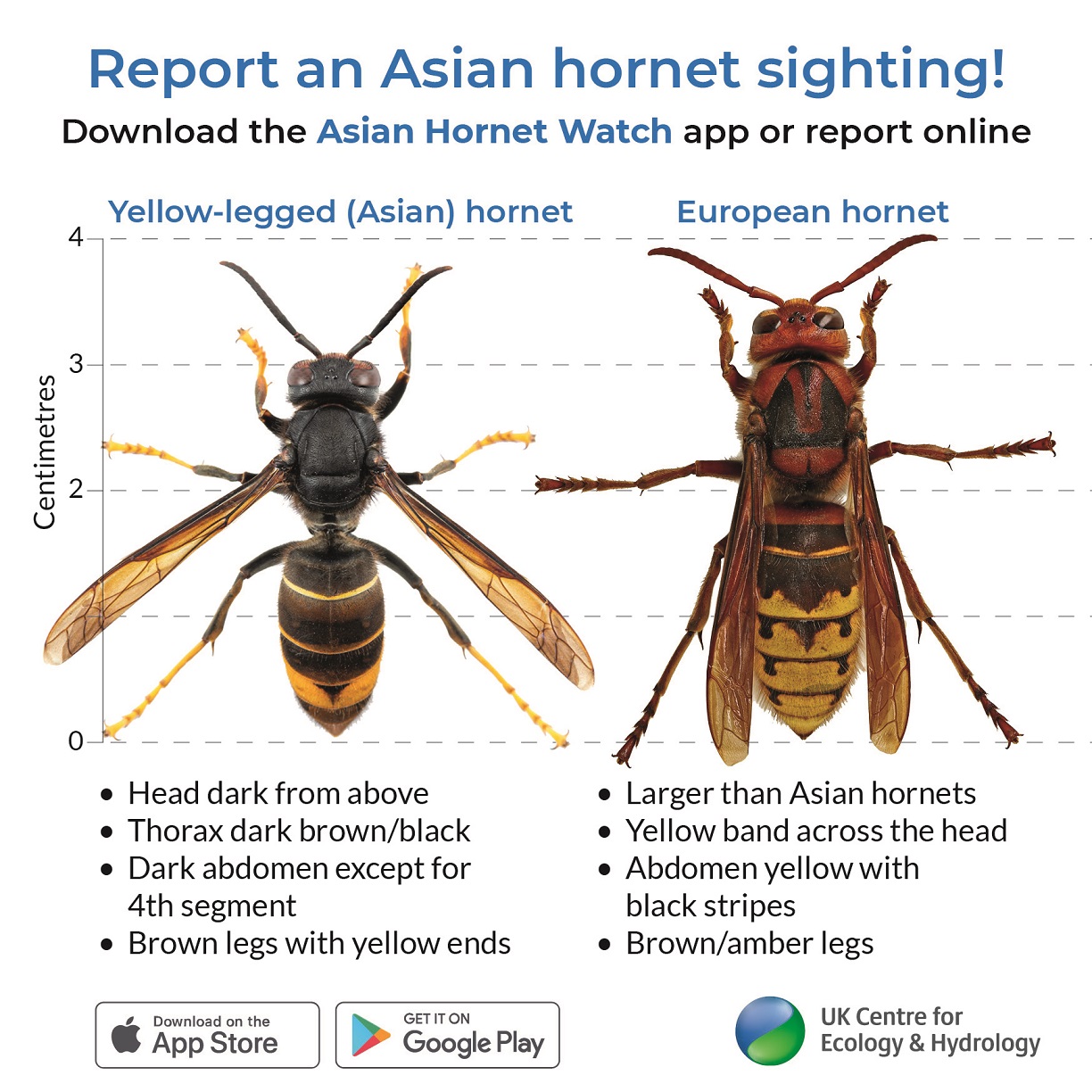A new study has shown that although the UK has suitable climate and habitat for the yellow-legged hornet, also known as the Asian hornet, effective action has prevented this voracious predator of pollinators from establishing here.
The invasive non-native species has devastated honeybee colonies in France and Italy.
It arrived in France in a container of pottery from China about 20 years ago, then spread rapidly across the continent, and was first seen in the UK in 2016. There have been regular sightings in the UK including 44 confirmed so far this year, mostly in Kent and East Sussex, but the National Bee Unit responds rapidly to reports, destroying the insects and nests found.
The UK Centre for Ecology & Hydrology (UKCEH) has led a study to assess the environmental suitability of European countries for establishment and spread of the yellow-legged hornet (Vespa velutina) and this work was the first to consider the potential extent of invasion by this species that would have occurred in the UK, Germany and the Netherlands if rapid eradication had not taken place.
Widespread threat
Using modelling approaches, they concluded that environmental suitability varied across Europe with areas of high suitability in France, Spain, Portugal, Italy, Belgium, the Netherlands, Denmark, Germany, the UK and Ireland. As of December 2023, the yellow-legged hornet is considered to be established in France, Spain, Belgium, the Netherlands, Portugal, Italy, Switzerland, Germany and Jersey.
The EU-funded study, published in the Journal of Applied Ecology, found that over 1,500km2 in the UK would have been colonised by 2020 without action to tackle the invasive non-native species.
Lead author Dr Richard Hassall of UKCEH explains: “No significant spread has yet been reported in UK and while there has been recent establishment in Germany and the Netherlands, our predictions suggest that the attempts to tackle the yellow-legged hornet in these countries have so far been successful in limiting its spread.
“This is due to the fantastic efforts by vigilant members of the public who report suspected sightings of yellow-legged hornets, then rapid action by the authorities to locate and eradicate the insects and nests found.
“Significant resources have gone into monitoring and slowing the spread of this invasive non-native species in the UK and parts of Europe, so it is encouraging to find these efforts appear to have been effective.”

Aiding identification
UKCEH oversees the alert system for Britain which enables people to report potential sightings of a number of priority invasive non-native species. The yellow-legged hornet is one such species and there are various ways that people can submit their reports.
The Asian Hornet Watch app, which has received around 12,500 reports of sightings from the public in the UK so far this year, though only a fraction of these are confirmed as yellow-legged hornet, with most observations actually of the native European hornet or hoverflies and other insects that look similar to the yellow-legged hornet.
The Asian hornet has recently been renamed the yellow-legged hornet in part to aid correct identification. In addition to checking the guides on the app and online, the public is asked to submit a clear photograph with their recorded sightings to help experts quickly identify whether it is a yellow-legged hornet.
Key role of citizen science
Professor Helen Roy of UKCEH and the University of Exeter, a co-author of the study, says: “We are grateful to everyone who is helping to track the spread of the yellow-legged hornet. The contributions of volunteers to citizen science initiatives such as the Asian Hornet Watch app are inspiring. The yellow-legged hornet is a voracious predator and has caused notable losses of honeybees in parts of Europe, and we predict there would be major impacts to wild pollinators in the UK if it establishes here.”
Along with UKCEH and the GB Non‐Native Species Secretariat, the latest study also involved the University of Turin and the International Union for Conservation of Nature (IUCN). The research team says the modelling framework developed in their study could be useful for evaluating the effectiveness of interventions for other invasive non-native species, as well as for risk assessment and guiding surveillance and management.
– Ends –
Notes to Editors
Paper information
Hassall et al. 2024. Predicting the spatio-temporal dynamics of biological invasions: Have rapid responses in Europe limited the spread of the Asian yellow-legged hornet (Vespa velutina nigrithorax)? Journal of Applied Ecology. Open access. DOI: 10.1111/1365-2664.14829
About the yellow-legged, or Asian, hornet
Originally from Asia, this invasive non-native species has spread across the world through cargo. Nests are typically found in tall trees in urban and rural areas, as well as garages, sheds and under decking.
The first confirmed sighting in the UK was in Tetbury in September 2016. Yellow-legged hornets prey on honeybees and various other pollinator insects, posing a high risk to native biodiversity as well as pollination of crops and flowers.
One study estimated that yellow-legged hornets have caused a 30 per cent reduction in honeybee colonies in France, at a cost of around 30 million euros,
There is relatively low risk to human health as the hornet’s sting is no worse than that of a bee but there is a risk if someone has an allergy or receives multiple stings, so people are advised not to go near nests.
How to identify the species
Unlike native hornets, the yellow-legged, or Asian, hornet has a predominantly dark body, with a yellow/orange fourth segment on its abdomen. its legs are brown with yellow ends. The yellow-legged hornet is also smaller, with workers up to 25mm and queens up to 30mm.
How do you report a sighting?
• Via the Asian Hornet Watch App, developed by the UK Centre for Ecology & Hydrology (UKCEH), is available to download for iPhone or Android devices.
• Via the online form.
• Email alertnonnative@ceh.ac.uk
Media enquiries
For interviews and further information, please contact Simon Williams, Media Relations Officer at UKCEH, via simwil@ceh.ac.uk or +44 (0)7920 295384.